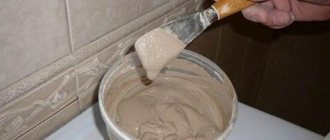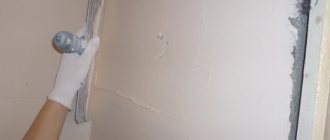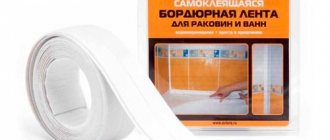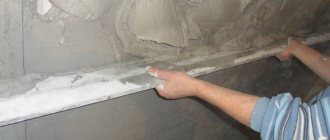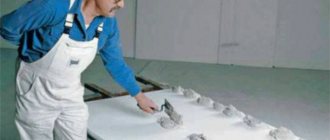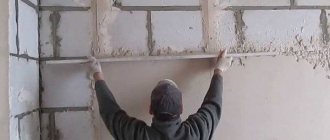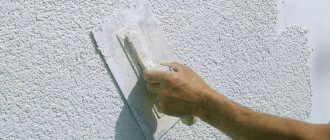How to paint the spaces between tiles
When choosing a material for restoration, you need to understand the conditions under which it will have to be used. A bathroom is an area of high humidity, where the walls and floor are constantly in contact with water and are subject to regular cleaning. Therefore, the coloring agent must be selected that can withstand significant loads.
Paint for tile joints must have the following properties:
- Strong adhesion to the material.
- Resistance to mechanical stress.
- Ability to constantly be in a humid environment.
- Good fluid retention.
- Disinfectant components included.
A wide variety of coloring products allows you to choose the right shade for any interior. The most common color remains white and its variations, since such tones are associated with the cleanliness and freshness of the bathroom. But if desired, the seams can be painted in any shade, for example, they can be made dark so that they contrast clearly with the tiles. Colored options are also available for sale; they can be matched to the main color or made into an interesting combination.
Tools for working with tiles Source hotel-a.ru
Water emulsion for seams
When choosing a paint for grout, craftsmen often opt for a regular water-based emulsion, since this product has many advantages:
- affordable price;
- ease of application;
- good grip on the surface;
- wide selection of shades on sale;
- environmental friendliness and health safety;
- quick drying after application.
Marker for tile joints.
It is also called a pencil for whitening joints, a unique development that helps to quickly and effortlessly tidy up the joints between tiles. Suitable for processing seams in any room, both in the bathroom and in the kitchen. More often, the marker is used to improve the appearance of old tiles, where seams affected by fungi and bacteria can simply be touched up without replacing the grout layer. Using a plumbing marker, you can paint over old stains, smudges, and disinfect seams, getting rid of fungus without removing the old grout. To get a snow-white result, you simply need to apply the special product between the seams. The marker is harmless, non-toxic, and not dangerous for children and pets. The main components of the marker include special white ink for various types of finishing work. Due to the absence of harmful components and solvents, it is odorless. The dye in the marker is waterproof, so getting moisture on the seams will not cause much harm and it can be used in rooms with high humidity. The plumbing marker contains a special fungicide and antiseptic that destroy harmful bacteria and microorganisms and prevent them from reappearing on the surface, thereby prolonging the long-lasting snow-white effect. Instructions for use are included on any pencil. A small writing tip is very convenient for painting dirty grooves near the sink or sink, between tile spaces. The ink does not dry for long and does not crumble for a long time. Some Chinese manufacturers produce not only white markers, but also markers of various colors, which can add originality to the masonry.
Pay attention to: Shoe paint: products for leather, suede and nubuck
How to Renew Epoxy Grout
It is easy to find a suitable dye for a cement coating, but the situation is completely different with epoxy grouts. In this case, the list of available options is significantly reduced. To remove the epoxy coating, wipe it with Litonit gel. Before application, the product is diluted in water and then carefully applied to the desired areas. You should work especially carefully in the tile area, since the substance is quite aggressive and can damage the surface.
Means for cleaning seams Source enzo.ru
If there are significant defects in the tile joints, it is more advisable to completely remove the grout and apply a new fresh layer. Using a sharp tool, carefully clean the gaps to a depth of about 5 mm, while trying to act carefully and not damage the surface of the tile itself. For the same reason, the use of electrical appliances is highly discouraged.
Cleaning the joints between tiles Source egida-sochi.ru
When the grout is completely removed, you can use a vacuum cleaner and carefully remove dust from all crevices. Then fresh mixture is added in between. To obtain colored joints, you can purchase ready-made grout with a tint or resort to an alternative method. It is the use of powdered pigments that are used in the production of concrete tiles.
Replacing the grout layer
Replacing the grout in the joints seems to be the most labor-intensive, but also the most effective and reliable way to update the color of the joint space.
To implement it, the first step is to get rid of the old grout. It is permissible to apply fresh grout over the worn-out layer of grout. Which is much less labor intensive. The main thing is to choose the right composition.
Therefore, you should figure out which grouts are suitable for these purposes. It is advisable to use two types of grouting compounds. Depending on the basis, this could be:
- cement composition;
- or epoxy.
A cement-based fugue is a dry mass diluted with water or liquid latex. Cement grout is always made using Portland cement.
Grouts based on epoxy resins are compounds with synthetic resins and hardeners that are resistant to acids and chlorine. Form strong contact with metal surfaces. For this reason, they are not susceptible to the influence of these substances and are characterized by a high degree of strength.
The cost of epoxy grout is higher. And their purpose involves their use not in residential premises, since the need to protect tile joints against alkalis and acids at home does not arise often.
Epoxy fugue has increased viscosity and is not suitable for thick tiles that are laid with small (narrow) gaps. The width of the joints is considered standardized, but the size of the gaps is determined by the shape and area of the tiles. For square elements 10 by 60 cm, the optimal seam width is 3 mm. In the case of defective tiles, the joint width can be increased to 1 cm.
To remove old grout you will need the following:
- knife;
- vacuum cleaner;
- gloves;
- spatula made of rubber materials;
- acid cleaner;
- soap (or washing gel);
- rags;
- primer.
Instructions for applying a new fugue to the previous one
- First, apply the grout mixture. The consistency should be similar to sour cream;
- Next, pour the mixture onto the floor in portions;
- And immediately, using a spatula, a wooden block or a piece of fabric, the mixture is leveled over the surface. This is why the mixture independently flows into all the recesses between the tiles and fills them. In this case, the grout should remain only in the grooves between the joints. Whereas the grouting compound is carefully removed from the coating with a cloth;
- After the grout dries after a day, a slight coating may be visible on the surface of the tile. It is removed by wiping the tiles with a cloth.
For work it is better to use a rubber spatula. It works well in tile recesses as well as seams.
The above recommendations are suitable in situations where the width of the seams is 3-5 mm. For narrower gaps (2-2.5 mm) proceed differently. First, evaluate to what depth the composition will fill the seams. If more than 3 mm, then grouting continues further. If the composition does not penetrate deeply, then use a spatula to press the composition into each section of the seams. Such a painstaking operation is performed only in areas that are subject to increased loads. In the remaining areas the composition is simply rubbed down.
To update the color of the grout, a colored fugue is well suited. The grout can be chosen to match the overall coating or in a contrasting shade. This way you can not only repaint the seams, but also create an interesting design for the room. To add color to the grout, the use of colors (dyes) is allowed. Typically, paste or liquid tinting agents are chosen, which are sold in a hardware store.
Industrial colored grouts contain a special dry tint, which creates a rich and bright fugue color. It is more appropriate to use industrial colored grout. Experts are against attempting to mix grout and color on their own. Because this is fraught with consequences. For example, damage to the performance properties of the composition cannot be ruled out; in addition, during subsequent mixing, you can miscalculate the desired degree of shade.
When the grout dries, it is covered with a special protective layer. This is necessary to avoid cracking at the seams.
Knowing how to paint the grout between tiles and how to change the grout in the joints will make your choice of resurfacing the grout more informed.
Dye application technology
Grout paint should always be applied to a clean, dry area. Typically a thin brush is used for this, but some manufacturers include their own tools. These can be sponges, brushes or tips. Greater precision during application can be achieved using masking tape. This material is placed on both sides of the treated area so that the dye does not get onto adjacent areas. After painting the gaps, wait some time until the product dries and distributes. When the final result is achieved, the tape is removed.
Processing seams between tiles Source termopaneli59.ru
If a marker was chosen for coloring, no additional equipment will be needed. The product is used to carefully paint the seams vertically and then horizontally.
Cleaning joints - home methods and remedies
Kitchen drawer cleaner
Stains and dirt at the joints between tiles can usually be removed with commonly available products, including baking soda, ammonia, vinegar, baking powder, and others. Most of them give surprisingly good results.
While there are various formulations proven to be effective, any grout cleaner is a good idea to try on a small area before tackling the entire wall. It never hurts to be careful and you can avoid discoloration or even damage to the grout between tiles.
Cleaning joints with baking powder
Baking powder helps with dirty joints in both the bathroom and kitchen. In addition, the space between floor tiles is improved thanks to the cleaning effect of this kitchen helper. The procedure is performed as follows:
- Make a paste with baking powder and a little water. To do this, mix the contents of the package with approximately 200 ml of water to obtain a thick paste.
- The grout cleaner is applied with a toothbrush.
- The baking powder is left on the joints for about an hour.
- The joints are thoroughly cleaned.
- All this is wiped dry with an absorbent cloth or towel.
Cleaning joints with baking soda
Homemade soda also does the trick, and dirty joints become fresh and aesthetically pleasing again. Mix 100 ml of baking soda with 300 ml of water and apply the resulting liquid to the cleaned areas using a toothbrush or microfiber cloth. After about an hour of work, the joints are washed with a damp microfiber cloth and then dried with a cotton cloth.
Nail polish remover and alcohol
These home remedies are often used to clean discolored and dirty joints. Simply moisten a cotton pad or cloth and rub vigorously. Additionally, alcohol and nail polish remover can kill mold. These home remedies are quite useful for cleaning small areas.
Descaling agents, fat solvents
Shampoo is a good grease remover, and dishwasher rinse aid removes limescale stains. Both can be used to clean joints, although on a fairly limited surface area. Therefore, before moving on to an expensive remedy, it would be good to check the substances that are at hand.
Steam cleaner
Tiles and joints can be thoroughly washed with steam, without the use of chemicals. Hot water steam also has the advantage that it not only penetrates deep into the joint and washes away dirt, but also kills bacteria at the same time. Steam cleaners are often equipped with special attachments and brushes to make cleaning easier.
Cleaning joints with vinegar
There is advice to treat dirty tile joints with vinegar: apply the liquid to the joints, rub thoroughly and after a while rinse with water. After this procedure, the joints should look like new. Error! Rinsing joints with vinegar gives a very short-term effect. Over time, vinegar damages the solution, causing it to become porous, which in turn allows dirt to build up.
Vinegar is suitable for cleaning silicone joints. After diluting with water, apply a cloth to the joints and rub in. If the stains are very stubborn, you can temporarily apply a cloth soaked in vinegar to the joint and then rinse with water.
When mold stains are discovered on silicone joints too late, neither vinegar nor other preparations wash them away. In this case, it is recommended to remove the old silicone and apply new grout. It is best to entrust this work to an experienced professional.
What paints to choose for the seams between tiles in the bathroom
To update the joints between tiles in the bathroom, preference should be given to specialized products for rooms with high humidity. Accordingly, their composition must contain components that prevent the proliferation of pathogenic microflora, suppressing its growth and vital activity.
Markers
Grout Aide & Tile Marker, an English-language commercial promises that the blackest grout will instantly turn white without any preliminary preparation. As people who use this product write, the effect of such an update lasts no more than six months.
Markers from the Japanese manufacturer Edding contain the protective components necessary to protect against fungi and mold. After applying the product, a thin protective strip is formed on the seam. Water will not get through it into the concrete layer. The marker is available with grout in several shades of white and gray.
More grout colors in specialized markers can be found from Chinese manufacturers. Bathroom renovations will be more economical if, instead of a marker, you use a bottle of grout equipped with a brush . This product is offered by the Italian company Vitrex, specializing in tiles and grouts.
